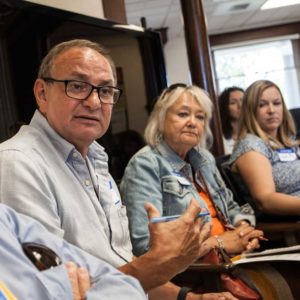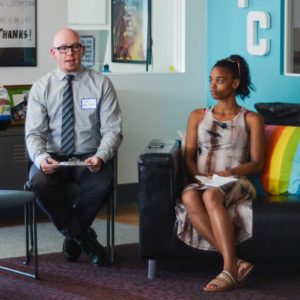By Jim Theofelis
Executive Director, A Way Home Washington
Washington state is in a unique position to be the first state to reach functional zero toward ending youth and young adult homelessness.
In Washington we call this “Yes to Yes.” When young people say “Yes, I want safe housing and a path forward,” local communities across Washington will be able to say in return, “Yes, come inside!”
Washington has worked hard to be in this position and we are proud to have such incredible service providers who work tirelessly every day supporting youth to exit homelessness. We also are proud of our lawmakers and the Governor’s office who are advancing public policy and budgets that support positive change and stay true to the state commitment that these young people in crisis are “our” youth not “those” youth. Most importantly we have a strong history of engaging those with lived experience at the table as leaders and subject experts.
During the last legislative session, we saw the passing of SB 6560, which states: “…by December 31, 2020, no unaccompanied youth is discharged from a publicly funded system of care into homelessness.”
This remarkable policy goal is aligned with the full expansion of the Extended Foster Care program, which also was passed during the most recent legislative session. Extended foster care ensures that the child welfare system has a program to ensure no young people age out of foster care into homelessness. Many of us also are still hoping to see Congress extend the age of extended foster care to 24 to align more with the developmental stage of young adulthood.
We are fortunate to have the Office of Homeless Youth, one of the first offices of its kind in any state, and the leadership of Kim Justice. The OHY is critical in bringing all the different conversations together in one place, managing the many different funding streams and setting a high standard of quality care by implementing performance-based contracts. Washington is the only state with an OHY and an organization like A Way Home Washington.
We also have tremendous philanthropic support and partners willing to step up and help. They see that now is the time for big change and are willing to support those changes.
All this combined makes our state poised to become a national model for ending youth and young adult homelessness.
The Anchor Community Initiative (ACI) will be a huge part of this model. The ultimate vision is for 12-15 communities to engage in a collective impact type effort to build the “Yes to Yes” system across our state. We have secured funding to launch the first cohort of four communities in September 2018.
We are gearing up to select the first four communities that will end youth and young adult homelessness by 2022.
While the first four communities will be important, those waiting for the next cohort will be just as crucial. For our ACI model to work, we will need all the potential communities to work together, learn from each other and be supportive of each other — just what Washington does best!
The communities that are not selected initially will still be critical partners as we are set for cohort two to launch in mid-2019.
We are committed to ending homelessness by looking at many different models, listening to local communities and young people with lived experience and exporting all the knowledge we gain across the state for collective benefit.
There will always be a family or a young person in crisis. The experience of trauma, mental illness and/or addiction is powerful and not easily overcome. For those young people who are saying “Yes, I want support,” Washington state and our local communities can be the beacon of hope that offers them a strong and resounding “Yes” in return. At least that is our plan in Washington state! “Yes to Yes!”
Together we are in a prime position to change the future for our young people.

 the expanding crisis of youth and young adult homelessness. Our task now is to ensure every community has the awareness, information and support needed to take action.”
the expanding crisis of youth and young adult homelessness. Our task now is to ensure every community has the awareness, information and support needed to take action.” services from
services from